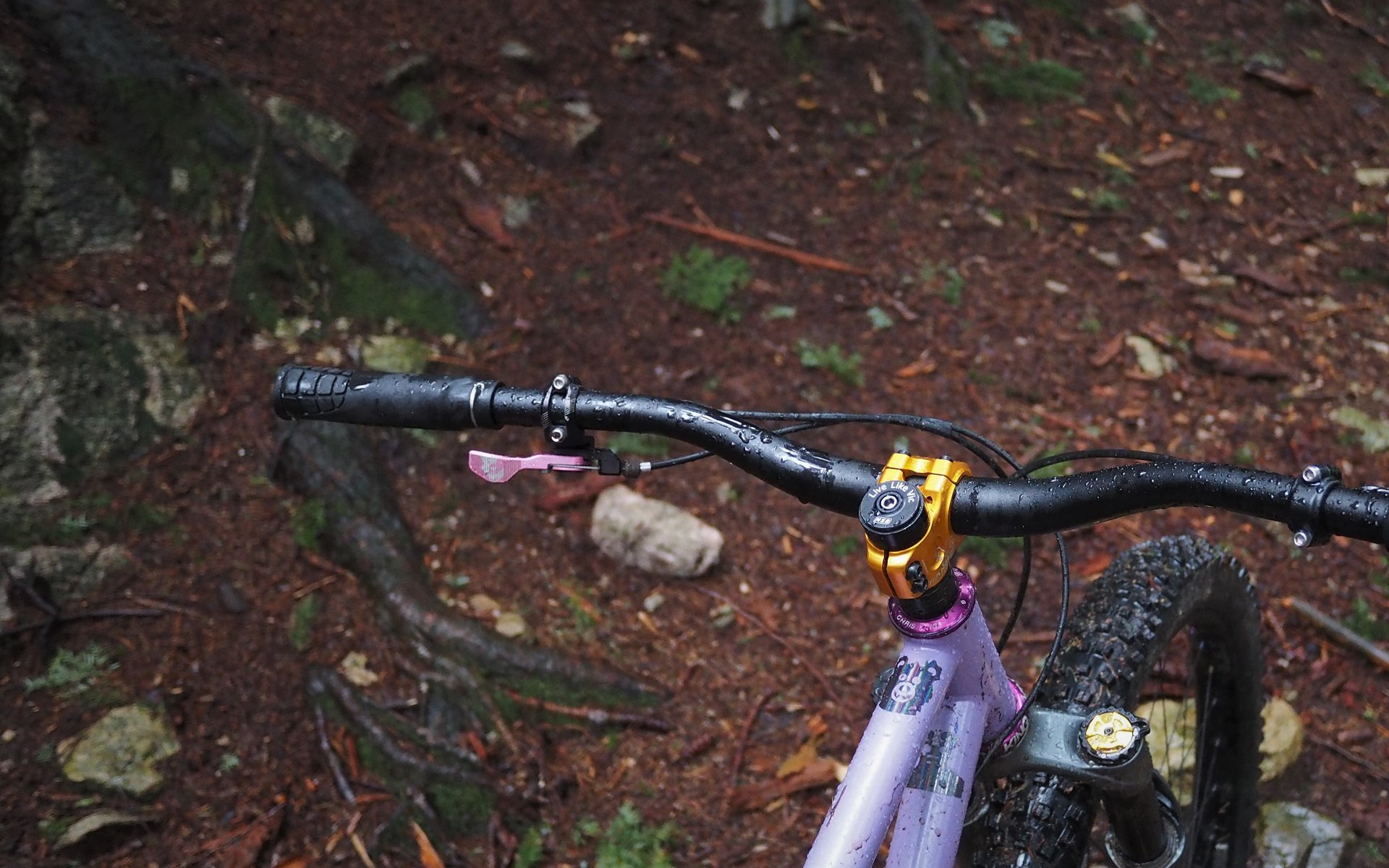
EDITORIAL
Close Your Eyes & Cut Your Bars
Have you ever found that last delicious chocolate easter egg a month after the event, hidden away in some random location and somehow, suddenly, more precious than a five-pound bag of the little treats? I was scrolling through a pile of old NSMB articles looking for inspiration when I came across Cam's 2017 editorial Going to Wide Bars (and back again). In 2018 it was my turn to take a bite out of the 'science' of fit with Handlebar Width & Staying Gracious and then the ripest of bike-fit-fruit went unpicked in 2019!
Now here I am like the lady in the IKEA ad yelling "start the car" as I pull off grand theft editorial, before any of NSMB's other test-writers can get in there, for what should be one of the most often replaced components of a mountain bicycle. I mean, let's face it, we all put our handlebars through hell and you're probably due for a new one anyway! How timely.
Wait just a minute before you fire up Chromag's website to see what colours of FU40 bars they're floating this year. I mean, yes, that FU-Blue is looking sweet-as in a 31.8 clamp and 7000-series aluminum, and if you aren't going to try something with more back-sweep then totally hit it. But, your current bar is probably good for a few more laps around the neighbourhood and you own a tape measure and a hacksaw. Let's experiment first!
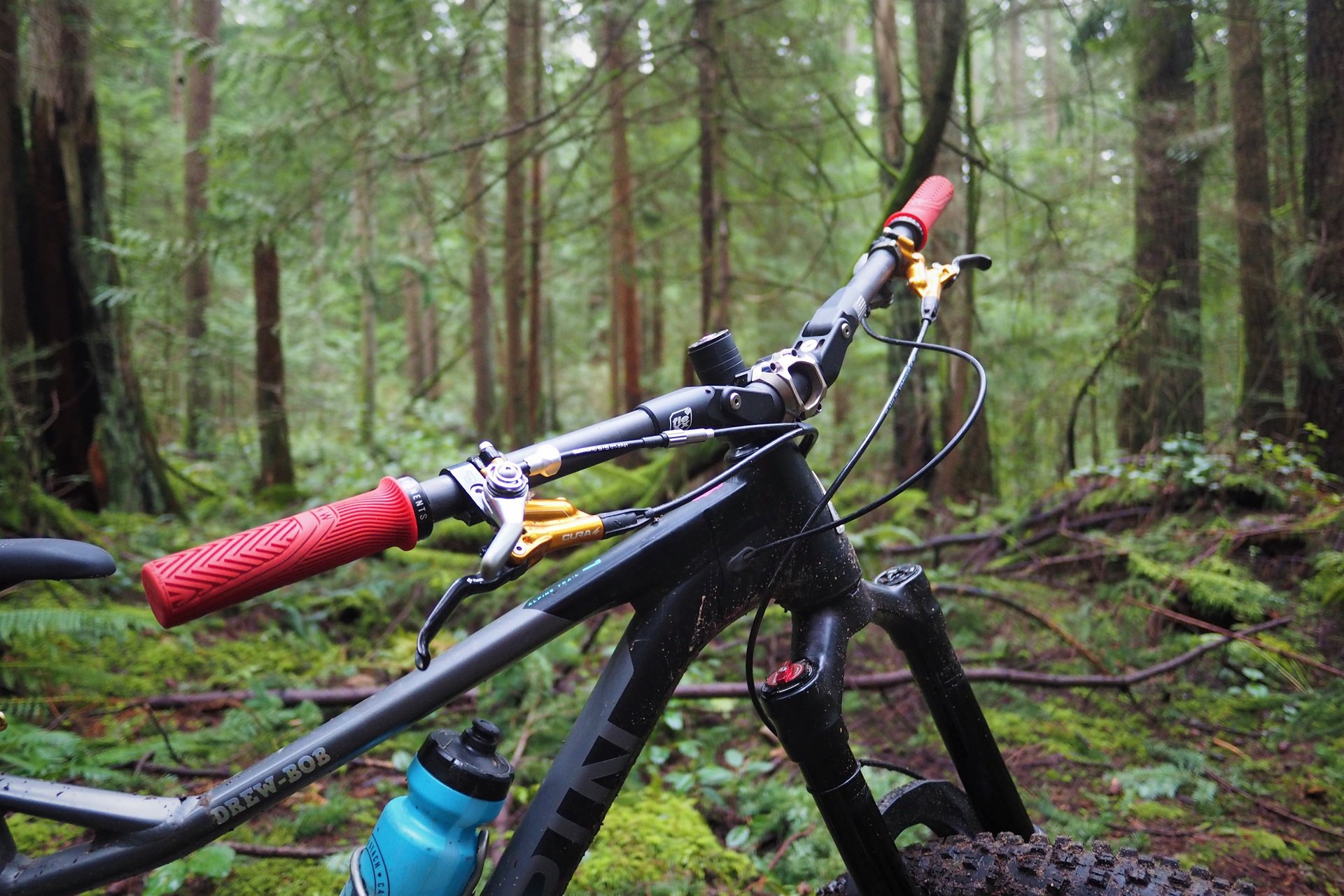
So far I've only cut the 800mm Fasst Flexx bars down to 780mm. That's been my preferred width on my Marin with a variety of bars but I haven't put time on anything narrower on this bike.
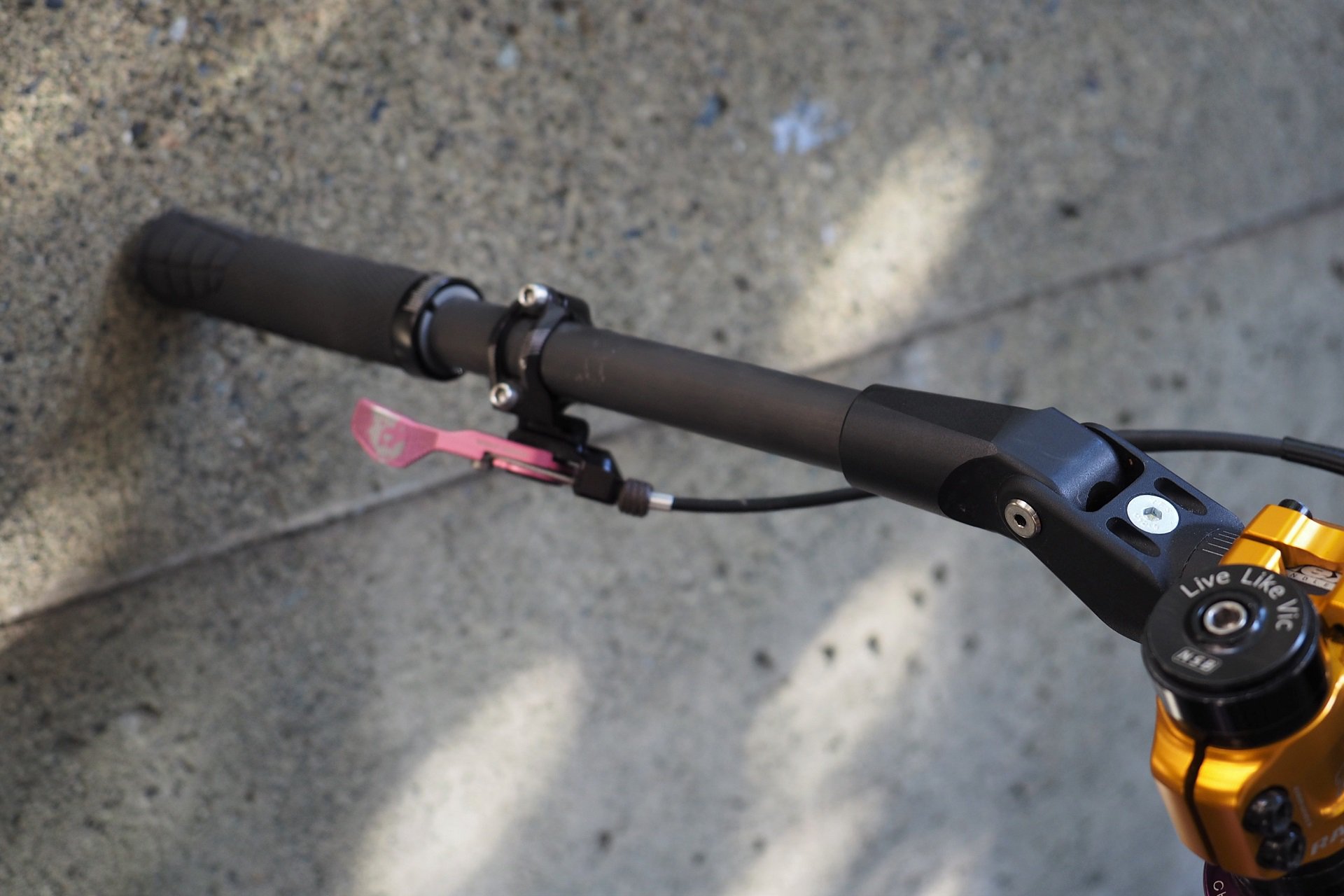
I have another 12° back-sweep bar I'll cut to 750mm first to confirm as there will be some variation in preference between bikes based on geometry. Can't go back once you chop 30mm off.
A lot of factors that led mountain bikers down the wide bar road initially don't apply to the current crop of bikes with modern geometry. The combination of a long reach, long wheelbase, 64° head tube angle, super short stem, corresponding fork offset, and big wheels combine to make bikes ridiculously stable. Weighting the front wheel is now more behind-than-above in terms of rider positioning but either way, it's much less tied to spreading those arms out and lowering the upper body. Wide flat bars and low stack heights haven't been in vogue for years for a reason.
I'm not trying to say that an 800mm+ wide bar isn't best for a specific rider, but when's the last time you really tried something different? Not on a friend's bike but on your own machine where it's really the case of just changing one variable. I rode 800mm wide bars for a few years and then started cutting them all down to 780mm, where I've been for years now. Then I followed my own advice, chopped an old bar down to 750mm, took it for a few rides, and now I'm eyeing up every steer-stick in the house.
And sure, I'd love for every rider to be able to try a few different back sweeps to find what works best for them, but that costs money. Playing with bar width is basically free in this situation!
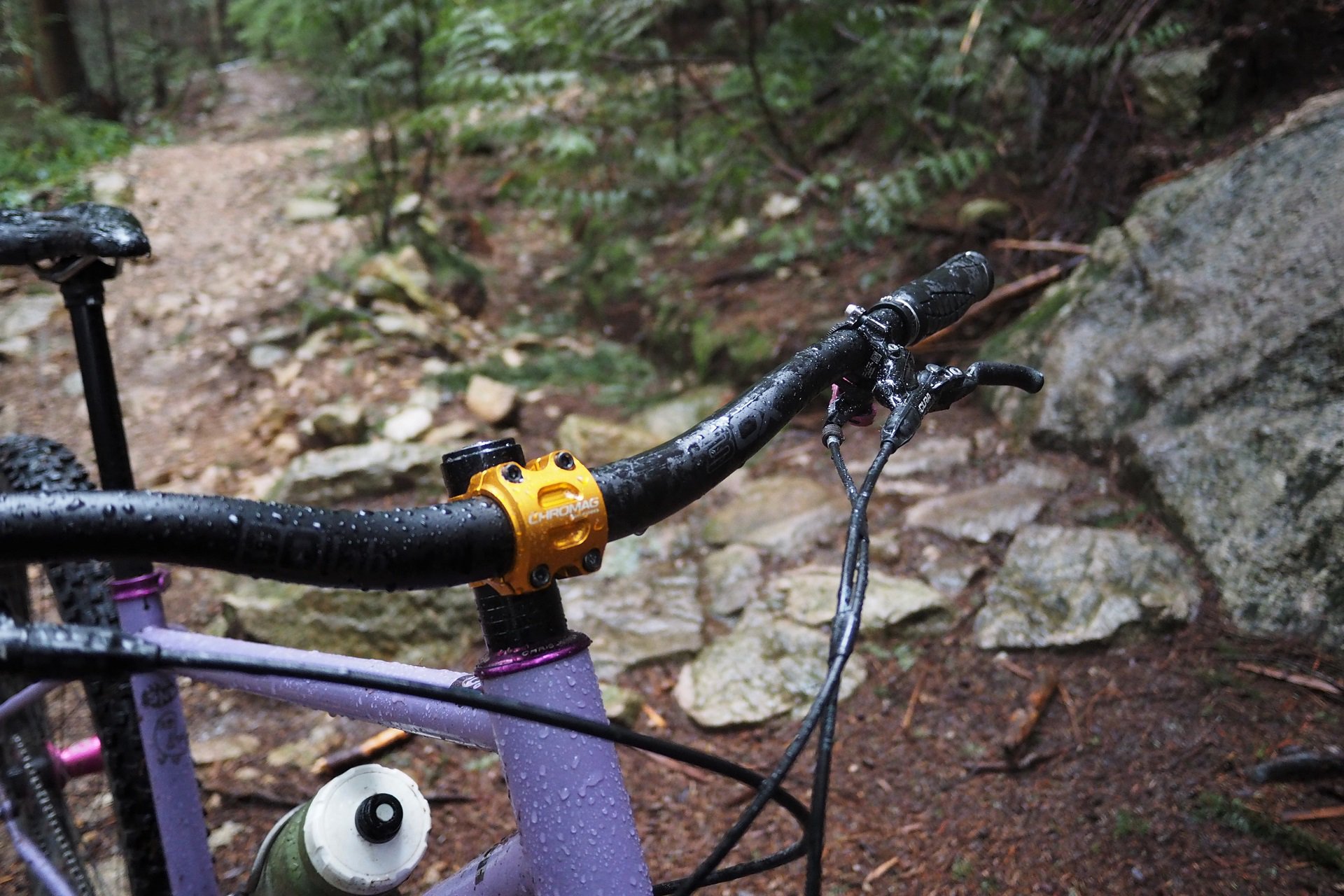
I'll cover this more in the (pending) write up of my personal bike, a Waltworks V2, but in switching from my rigid to suspension fork setup I also needed the bars higher so I'm now running the tallest version of SQLab's 16°-back 30X aluminum bar.
Now, don't bother just moving your controls and grips inboard. It's like saying you've tried single speeding because one time you went on a ride and didn't shift for ten minutes. You sound like a goof and it really doesn't work that way. For one, if you live anywhere with trees you're going to be smoking those bare bar ends, but more than that you can't rotate your hands to as many different positions over a ride and the narrower setup won't feel comfortable.
You really have to cut the bar down, ride it a couple of times and then - once you're used to it - decide if you prefer it wider, at that width, or trim it again. For better or worse, I think many riders will be surprised by the difference that 20 or 40mm of handlebar width makes to how their bike rides.
There's no financial risk when it's time to replace a handlebar anyway, and I had a couple that were ready to be up-cycled into gardening stakes or door jams so out came the saw, tape, and cutting guide. My first-gen Park SG-7 has paid for itself a pile of times over between all the bars, posts, steerer tubes, and non-bicycle cuts I've made but if you leave your bar installed on the bike there are plenty of different ways to ensure a straight, or straight-enough, cut for this process.
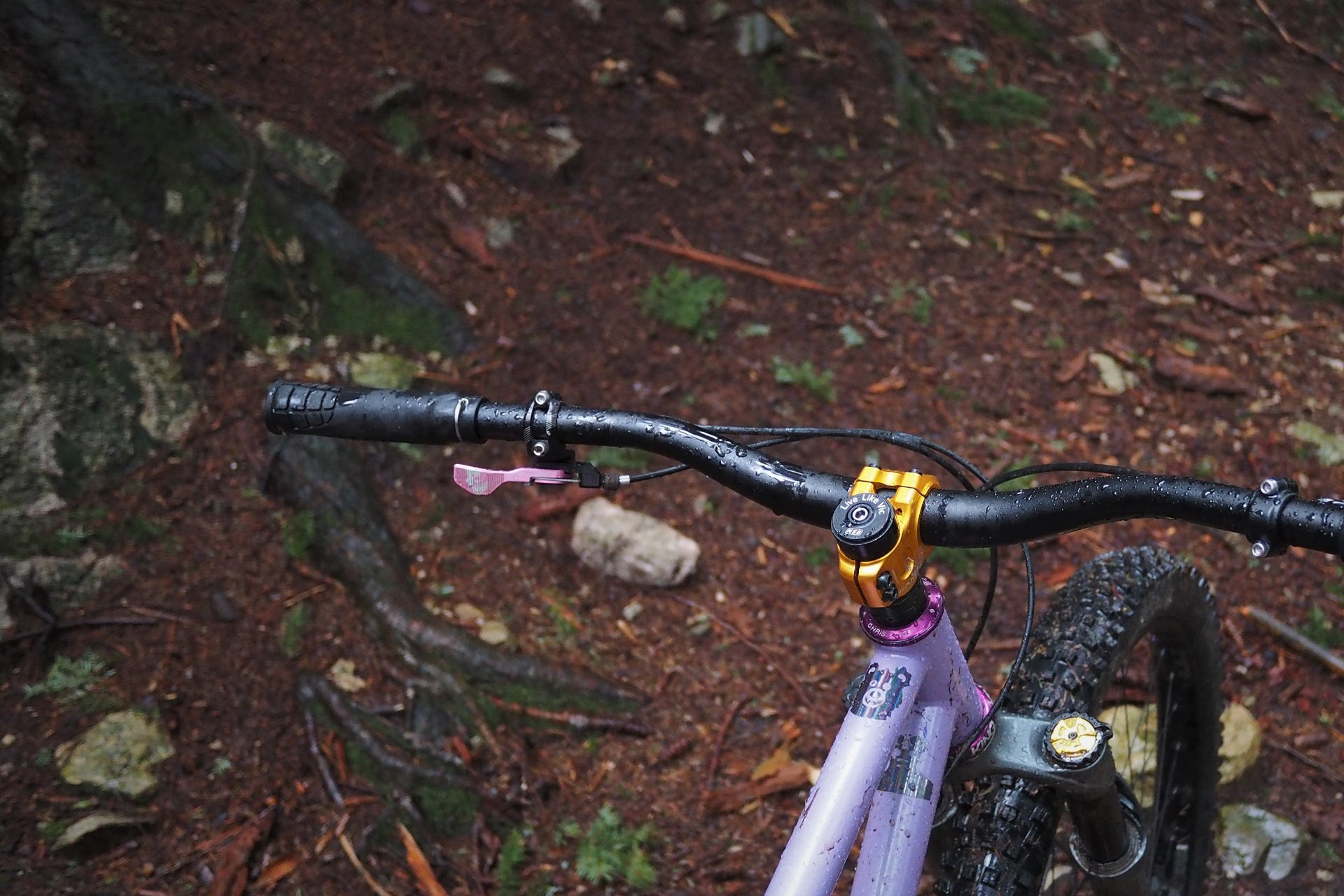
I took Mercedes Gonazalez' advice, from a '90s interview, as I remember it. I closed my eyes and cut the bars where my hands felt good, at 750mm wide. When my new steer stick arrived I chopped it to the same without thinking twice.
Now, don't bother just moving your controls and grips inboard. It's like saying you've tried single speeding because one time you went on a ride and didn't shift for ten minutes.
I had no idea how much I wanted to trim at first but when I started thinking about it for some reason I could recall this interview with Mercedes Gonzalez in one of the major mountain bike mags in the 1990s where she said she figured out her ideal bar width by closing her eyes and putting her hands on her bars. So I did that. I landed at about 750mm so that's where I made my cuts. I rode the bar for three rides, loved it and then hacked another centimeter off each side just to be sure and that wasn't nearly as good. Boom, science.
I'm taking it nice and easy on the bikes these days so to keep things entertaining I've been experimenting with tire pressure, handlebar height, saddle position (fore-aft and tilt), cleat position, and anything else that strikes my fancy but thus far nothing as eye-opening as when I chopped my bars down.
Maybe give it a try? After all, as we agreed above, you're probably due for a new one anyway!
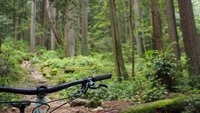

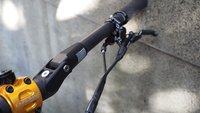
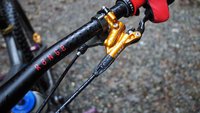







Comments
taprider
4 years ago
I find with more reach the narrower I want the bar
Reply
Andrew Major
4 years ago
To a large extent that’s what I’m suggesting re. a person’s legacy bar width v. a bike with modern geo. The slacker head angles and reduced fork offsets (paired to short stems) all play a roll.
Reply
Cr4w
4 years ago
Can we also refer to peoples' legacy reach/ETT numbers versus HTA?
Reply
Andrew Major
4 years ago
Definitely included under modern v. legacy bike geo, or actually given folks fluidly sizing up/down I appreciate your thought re. better to talk about legacy fit v. geo.
Reply
taprider
4 years ago
Back in the days of Test of Metal and narrow bars, the first guys through Roller Coaster were going straight off the log drops and had flat backs and were very low and over their front wheels. The further back in the field the racers were, the more behind the saddle they were (common observation for all BC XC races). Seemed like a direct correlation between forward + low and how fast an XC racer was down technical terrain. However, the fastest racers were also doing a lot of lifting and thrusting of the bars in anticipation of the terrain, rather than just sitting back with locked arms and letting the bike do the work.
Some people seem to think your push up width should be your handlebar width. But I challenge them to try hand clap push ups with a wide stance rather than hands more directly under the shoulders.
Reply
bumVSmtn
4 years ago
I’ve been a 30.5” guy for years on my 27.5 bikes, even with modern geo.
Going to my first 29er this past year with a 42mm offset fork (Honzo with Pike) and a 30mm stem, I found I was reaching a critical point with my steering at which it felt I was over-leveraging the steering.
Thankfully this only resulted in one crash at the end of our riding season in November, but had a couple saves that I pulled back.
After much time marinating on this issue, bar width was my likely suspect, and after reading this article, I’m for sure going to cut down and see how it affects my bikes handling.
Reply
Andrew Major
4 years ago
I think you’re spot on, although the stock Honzo has a steep HTA. Definitely report back what widths you try and how it works out for you.
Reply
Andrew Major
4 years ago
My favourite Honzo setup involved a Works Angleset and over-forking the bike. I owned, and loved, a pile of Honzo's going back to 2011 (when I got my hands on one of the first 2012 frames).
Reply
bumVSmtn
4 years ago
I seemed to remember your being a Honzo aficionado!
For sure a steepish head angle at 68 so not truly modern when compared to some of the more aggressive hardtails in its class.
Forgot to mention that my Pike is 130mm so not hugely over-forked.
The 30th anniversary Honzo ST was spec’d with a 46mm offset but the 2020 ST ended up back at 51mm.
That “critical point” I mentioned was unlike anything I’d ever experienced on any bike and as mentioned I found it about 6-7 times this Fall, all in the exits of slightly insloped turns (not deep berms).
Can’t wait to trim the bars and report back- though it will be a little bit given our world at this moment in time.
Reply
Andrew Major
4 years ago
Yeah, full-on Honzo lover. Just wish that they'd update it as they have every other bike in their lineup. The Kona Unit has more aggressive geometry now. I always road mine with a 140mm fork / 51mm offset / 50mm stem when I road mediums. That worked great.
With the Angleset I upsized to a large, ran a super short stem, 170mm fork (short offset), 29+ front tire and the thing was a Beast. Truly loved it despite my previous belief that less travel makes more sense on hardtail because of geometry change through the fork travel. It turns out that's only an issue if your bike isn't slack enough and/or your Stack isn't tall enough for your Reach.
bumVSmtn
4 years ago
Some pics of my Honzo:
Andrew Major
4 years ago
Man, there are a lot of gears on there?! (kidding, kidding - don't mind me).
bumVSmtn
4 years ago
This comment has been removed.
DMVancouver
4 years ago
I found moving controls and grips in (with bar plugs!) to be a fine way to test out narrower bars. I kept it like that for a month before pulling out the hacksaw.
Reply
Andrew Major
4 years ago
As always, YMMV. How much were they moved inboard? In my case a 30mm cut would have meant 1.5cm sticking out each side.
Originally I’d included some straw polls I did of friends - who had tried narrower bars, moving grips v. cutting, who moved back after but it was unwieldy. Still very curious to hear how folks’ experiments have gone.
-
Two other things not explicitly stated in the article. 1) Some folks are riding around on bars that have been scary-abused over long periods of time; they’re not really expensive to change. Good reminder I think. 2) Not suggesting anyone empty their savings or abuse their card, but if you were going to spend some money on your bike this year anyways it’s not a bad time to support a company you like.
So yeah, killing three+ birds with one bar piece!
Reply
Andy Eunson
4 years ago
I’ve been watching this YouTube channel https://youtu.be/EFUTFmZHq_4 which is all road bike stuff but really interesting. In the attached video he talks about road racing in the 80’s where aluminum bars were retired annually because it was safer and pretty cheap. He comments that one might be less inclined to retire an expensive carbon bar after a crash as opposed to a cheaper aluminum bar. Lots of those road bar failures are at the stem clamp edge because that’s where the forces of a crash concentrate. Makes sense to retire bars annually or after a (Andrew) major crash.
I’ve done that cut down and old bar test too. 740 seems to be a good number for me. At 760 I did nick the odd tree. At 760 I did not put my hands at the end of the grip but inboard a touch. So I took that as an indication that a narrower bar would be better. Plus as you narrow your grip, you may not want as great a sweep as with a wider bar.
Reply
Andrew Major
4 years ago
Total aside, but you may appreciate this, I been working on a MEATengines piece tentatively titled “We’re All Running That Short-Person Fit.”
I remember talking to shorter customers in the shop about longer travel (140-160mm) bikes and how we had to compromise on fit to make them work for them. We’d push the saddle forward on the rails (“less good pedaling position”) and run super-short stems to make the bikes fit and the handlebars would regularly be as high (or a touch higher) than their saddle at full climbing height.
Now that’s basically every bike of every size in the forest as proportional Reach requires proportional total-Stack (bar height v. BB).
Reply
Andy Eunson
4 years ago
Wha da ya mean short. I resemble that comment.
Reply
Jonathan Schwarz
4 years ago
This piece sounds interesting!! I've been reading more on forward geometry but still can't find much in the way of actual sizing suggestions. Some bike brands seems to be more forward geometry oriented (Norco, Kona). But then Rocky size charts put me on a Large with a HA 66, STA 74.5, Reach 454 and ETT 624. I've been gleaning some tips from comments in forums but still trying to figure out how that applies to myself.
I'm 182cm, 186.5 armspan, 87.5cm inseam. Would love to hear any tips you have on finding an ideal reach/stack/ETT. I know riding is the best way to figure it out for yourself - but it can be tricky getting to demo a bunch of bikes, combined with the small stem/bar/seat offset changes you would need to make to get that ideal balance. Having a ballpark to start with to find a frame that would work - that would be awesome
Reply
Tehllama42
4 years ago
I'm 188cm, and ride an XXL Rocky - the sizing suggestions are just that, no need to be tied to them. I also own a 'Large' rocky in 454mm reach.. I proceeded to slap a 40mm stem and 750mm bar on it for my wife to use, because I couldn't make that fit correctly for me.
Demo is the answer - oddly for me it was riding a few Santa Cruz and Yeti bikes of that demo fleet, most still couldn't fit me how I was looking to (and most of the time there's one token XL bike), but the one revelation was the Hightower XL with 475mm of reach and a 780mm bar/50mm stem setup - it was the closest thing I'd ever experienced to correct fit up and down - so I felt adequately prepared to try going to 485mm reach and an 810mm bar knowing I could cut down the latter.
So, use demo days to try sizing as well as bike performance, for sure.
Andrew Major
4 years ago
Seated geometry still matters on everything that’s not a DH bike (what Reach & Stack we’re developed for) so in addition to that Reach/Stack relationship the actual effective top tube at climbing height is important. The slacker the real ETT the shorter tge Reach for the same fit.
I like a long wheelbase (and standing Reach) and I don’t love super steep STAs so the perfect balance of fit is tricky to achieve (the bigger the princess the bigger the pea).
Short offsets and slack angles mean your new rig will ride great with a short stem and narrower bar (if you want) so there are fit options with larger frames.
I’m 5’9” with T-Rex’s ape-index and my personal hardtail has a 480mm Reach/ 600mm Stack with a 73.5° STA and that’s sagged (not static) geo so I’m in the camp of folks that figure many companies have room to grow their stock sizes (especially with 76°+ STAs)
Andrew Major
4 years ago
Aside from working with a great custom builder, having a solid idea of what you want and how all the numbers work together, or dealing with a really competent company that will back up there advice then I highly recommend sitting on a (model of the) bike before you buy it. A range of Reach measurements that work for you (standing) is good to know (I adapt well to 450-480+ depending on stem/fork offset) but that STA / ETT is something I think you need to feel.
There are brands that do a lot of direct sales where the company reps really know their stuff. For example I know a lot of folks who’ve dealt with, specifically, Cavan at Knolly and he’s dialled on getting you set up between your dimensions and preferences.
Jonathan Schwarz
4 years ago
Thanks Andrew (and Tehllama)!
Sounds like I should try a few bikes with a variety of different reaches to see what feels good and work on finding what that usable range of reach is for me. And if at 5'9", you find a reach 450-480+ works best = sounds like the Instinct with a 454mm reach is gonna be too small for me.
And yes, I'd gleaned that the ETT combined with reach is an important measure to note as the seated cockpit is very important (where you spend most of your time, climbing). Essentially - ETT for seated reach, Reach for standing reach.
Did you mean "The slacker the real HTA the shorter the Reach?" or "The slacker (shorter) the real ETT the shorter the Reach?"
Do you find there is a much narrower range of seated cockpit reach that works for you than the standing reach measure? Ie. Do you adjust your cockpits (saddle position/stem/bar) so the seated reach is within only a few mm of each other?
Tehllama42
4 years ago
The slacker the effective seat tube angle, the more ETT you get for the same reach. - this is how old school bikes and road/gravel bikes are still fit to riders, because weight distribution is much better on flat ground.
Basically, but making the seat tube steeper, you're moving the rider position forward (angularly over the bottom bracket) so that they can reach the bars in the new revised more forward position. You're right that the effective top tube length is a range, but that range for maximum rider performance isn't really that big.... but if you move the seat tube to accomodate the reach adjustments (basically moving the rider forward relative to the bottom bracket while seated by moving those touchpoints forward), it does work. Arguably this is only helpful if you can utterly ignore the seat when descending... but that's the elegance of a dropper post.
As far as why the slacker seat tube and shorter reach to get the same ETT is common is that for road/gravel and other flat applications, you end up with a better weight distribution for that application (you don't want as much weight on the front unless you're climbing and unweighting that, or having a seat in the way of where you want to be when you're descending)... just took a while for that full realization that more reach can be a good thing provided you move the whole rider position forward and work off the assumption that riders will use a dropper to take the seat out of the equation (also, slacker head tube angles with more front center length helps with not having rider mass go forward of the handlebars when encountering obstacles)
Andrew Major
4 years ago
Great post T-42,
Only thing I'd add is that there's a balance between standing (Reach) and sitting (ETT) v. pedaling position. I really like a long Reach standing but I can't stand really steep seat tube angles so it leaves me trying to balance a seated riding position with a <74° STA with the standing position I prefer. My current custom walks that line balancing on my big toes while drink Tequila straight from the bottle with a 480mm Reach and 73.5° STA (I'm 5'9).
DMVancouver
4 years ago
@Andrew Major - "How much were they moved inboard?"
I went from 780 (which I had been running forever) to 760. Trying to feel comfortable on my new long, slack bike led me to question longstanding bike setup points. Your article is spot-on - I have ended up with narrower bars and more spacers under the stem to feel like I have room to move around on the bike and not just locked in forward.
But yeah, having 1 cm of bar sticking out from beyond my grips didn't bother me much.
Reply
Andrew Major
4 years ago
“Locked in forward” is a great way to describe it. Cheers!
Reply
fartymarty
4 years ago
IMO bar width should relate to shoulder width. I have fairly wide shoulders and ride 780s which feel comfortable.
What is everyone's shoulder widths (measured arms down against a wall) v bar widths?
The other way to measure would be to let your arms drop and get someone to measure outside to outside.
Reply
Andrew Major
4 years ago
Ape-index maybe factors in as well? Interesting though as I imagine there’s some correlation between shoulder width and blind-sizing.
Reply
Tehllama42
4 years ago
Nailed it - I'm 21" horizontal, in the +3 ape index land (6'2"), so it probably makes a fair bit of sense that 810mm or wider is where I'd be by default.
Reply
Vik Banerjee
4 years ago
I've never had ergonomic issues with narrower bars. Going to 800mm bars...because that what was cool I had some pretty severe RSI in my forearms/elbows. Now I am back to 780mm 12/16 deg sweep bars and 760mm 8/9 deg sweep bars and my arms are happy again. After a moment to adapt I don't find any difference in ride experience vs. wider except I don't hit as many trees!
Reply
Andrew Major
4 years ago
Now that’s interesting. I’ve been running my straighter and more backswept bars at the same lengths. What was the initial motivation to go narrower with the straighter bar?
Reply
Andy Eunson
4 years ago
Makes sense. Put your arms out wide, keep your wrists straight and then put your hands together. See what angle your “grip” is at. The wider the bar, the more sweep you’ll want.
Reply
mrbrett
4 years ago
Could be worth a shot. I've been thinking "Wide! Wide! Wide!" For bars for years.
My hierarchy of part usage, from new to old is: my bike -> commuter bike -> kids bike, so chopping some bars down might be safe enough.
If it doesn't work, that's one step farther down the chain, where narrower bars are a bit more appreciated anyway.
Reply
Andrew Major
4 years ago
If you give it a shot for a few rides - even tame ones - I'd be curious to know what you think. What bike are you riding and did you size up, right-size when you bought it?
Cheers,
Reply
mrbrett
4 years ago
Process 153, and I'd say I right-sized it. I figure if I chop my 800mm Fatbars down to 760 that should be a good start.
Definitely not a high stakes experiment by any means. I will get a saw and cutting guide out on the weekend.
Reply
Andrew Major
4 years ago
Cool, please report back with your results.
Process 153 has a decently large Stack v. Reach so lots of replacement options. I’m finding a lot of new bikes need a lot of rise & headset spacers to fit around their short Stack/long Reach fits. Although could be my T-Rex arms.
Reply
DanL
4 years ago
Then I'll be cutting too - 153 with 780mm OSX fubars, low stack and 50mm hifi stem. My grips definitely sit outside of a shoulder - pushup width by about 10mm either side so let's see!
PSA I'm also one of those weirdos that's considering getting the vertical wolftooth bar-centric dropper lever too
Reply
Andrew Major
4 years ago
Are you looking at the bar-centric because you run a front shifter or for ergonomic reasons?! Very intrigued.
I’ve been really consenting going back to 2x10 on my personal bike with a manual granny shift.
Reply
DanL
4 years ago
Quick report back, but unfortunately I moved several goalposts.
Cut bars by 10mm either side so the OSX fubars are down to 760mm, but also increased the stack under my 50mm stem by 55mm and then put on a 170mm crank instead of 165s, haha.
Oh and replaced the Sunrace 11-50 11spd with Sunrace 11-46 10spd but keeping a 28t. That 50 was dead weight I think.
The noticeable change - handlebars first to keep it on message - was a better feeling of tracking through corners especially on the tight sections of Kirkford without having to pin my chin to the stem.
Climbing was easier in some places as I was more upright but I'd put that down to the stack under the stem - the Front wheel a little light on steep uphills requiring a little more hanging over the bars.
As for the lever, I'm really thinking of bar-centric for ergonomics, my main thumb joints are getting old and bent and this feels like less leverage on it. From what I remember of the OEM KS Lev lever I had. PNW do one as well as do WolfTooth.
/edit -> just ordered the PNW puget lever
DanL
4 years ago
This comment has been removed.
Tremeer023
4 years ago
I went from 800mm to 780mm and it feels much better (I'm 182cm tall). Used to run 760 on my DJ bike and may well try that for a while as most of my riding is relatively lower speed.
My current carbon bar has a few scratches and I'm interested in trying a 12 degree back sweep bar instead so good time for an experiment as you say.
Reply
Andrew Major
4 years ago
Cool! Please report back with your results (and how you like the 12° bar)
Reply
Cr4w
4 years ago
At 198cm with a +17mm ape Index If anyone needs a wider bar It's me. I have a 820mm SixC bar on one bike and I got a 800mm NextR on another. Wow the narrower bar Is much better (and It's actually a bit more compliant). If 800 Is good maybe 780 Is better.
Reply
Andrew Major
4 years ago
I’m still waiting for someone to order an 840 Manticore just so I can see one in person. If it isn’t going to be you I think I may have to let the dream die.
Reply
Cr4w
4 years ago
It's not going to be me. If I ever go SS I might reconsider but until that happy day I've gone big enough for now.
Reply
Jon Durnin
4 years ago
Back when Cut Yer Bars was the trail to ride in Whistler, I figure my bars were 400-440. Plus the required Synchros steerhorns.
Just enough room on my rigid RM Blizzard with the banana bend forks for ODI mushroom grips, shifters, and the cantilever brake levers. My shoulders are wider. But that was on trend for the day.
Reply
Rob Gretchen
4 years ago
Man, I appreciate what you are saying Andrew... but I hate cutting handlebars.... what's wrong with 820mm, ha ha!! But seriously as a dude riding at 230 without gear and being a self-proclaimed wide body I am comfortable at 800mm, especially on terrain where you are going fast... slower speed tech, with narrow trail and trees, yeah those pinkies can take a beating.
Reply
Andrew Major
4 years ago
I hate cutting carbon handlebars. Clean saw blade, taped cutting zone, careful technique, and there’s still always a chance of loose fibers or a split on the end.
Aluminum isn’t a big deal though and nice aluminum 31.8 bars are where it’s at right?
Reply
WheelNut
4 years ago
You should use an abrasive hacksaw blade (or an angle grinder with cutting disk) when cutting through carbon rather than a toothed blade. It gives a much smoother cut and won't tear the fibers out. Also, wear respiratory protection as carbon dust is supposedly very bad for your lungs.
Reply
Andrew Major
4 years ago
I need to buy an abrasive hacksaw blade for sure - I don't see straight so cutting a bar without a guide would be a BAaaaaaaaaaaaD idea for me (cutting disc).
Reply
Morgan Heater
4 years ago
I'm 6' tall, and have a plus two ape index. I like running my bars at about 765. I decided on the width by doing pushups to failure with my hands at different widths, and it made me feel a lot stronger on the bike.
I think the wide bar craze probably originally came about from the watch-makers tool idea where big motions at the hands lead to smaller motions at the wheel which makes the steering less sensitive and more difficult to make mistakes. New, slack, long wheelbase bikes are already sooo stable, it seems like it's a lot less necessary, and slightly twitchier steering probably makes more techy climbing and descending easier.
Not to mention giving you a stronger position to resist g-outs, repeated chunky hits, more elbow articulation to bunny hop/pump/manual, etc. etc.
When I see short people on long bikes with wide bars it triggers my nerd. It's very difficult for me not to strike up a conversation and try to lead them around to bar width and then spray my opinions all over them. Similar to watching people work on jumps with their seats up. Or watching dads pump their kids tires up to 35 PSI at Duthie. Or anyone that has their brake lever mounts inside their shifter or dropper levers.
Reply
taprider
4 years ago
reminds me of that Zoe Pink Bike video series on training to be an enduro racer
Reply
Lu Kz
4 years ago
Yes, I'm sure it was Big Watchmaker's influence on mtb that caused us to have wide bars.
Reply
RNAYEL
4 years ago
I went to 800mm wide bars early, back in 2008 when the only option was the FSA Gravity Light Super Wide. I was getting my bike serviced at North Shore Bike Shop and Matt noticed that my controls were right up against my grips and the outside of my grips were word because my hands were hanging off. He suggested that I try these wide bars that he had on order. Haven't really gone much narrower since.
I'd be willing to try something narrower again, maybe in between the 740s I'd been running in early 2008 and the 780mm-800mm that I've been running since.
Reply
Andrew Major
4 years ago
My first wide bar was the 800mm Gravity ‘Fabien Barrel’ bar as well! Then a fully flat Gravity 777 bar.
It was pretty amazing. Hands no longer hanging over the edges, better front wheel traction... I think A Lot of riders had a similar experience but today’s medium frames have longer top tubes than the XL bikes back then; fit has changed a lot even with the 20mm-ish shorter stems we’re running now.
Anyways, why not experiment and find out if 800mm is still best for you? Get the kids to help!
Reply
Nouseforaname
4 years ago
I ended up on a shorter reach bike and I'm constantly feeling like I'm compensating by shifting my hands wider on 780mm bars. On the longer bike they felt great, and I probably could have cut them. Now I wish I had ODI screw in extenders.
Reply
Andrew Major
4 years ago
How much difference in Reach between the two bikes?!
Reply
Dude@
4 years ago
I am always tinkering with bar, stem, spacer set-up, and bar rotation. I find bar rotation makes a big difference in finding the natural position to ride out of the saddle, whether you are weighing in front of the axle or behind the axle. Some bikes feel better riding in front, some behind. I find when you hit the neutral spot in middle, steering gets weird, as if the front end isn't weighted properly.
I tend to run narrower bars for years ~760-770mm. Recently got tried wider - move the grips that have an integrated out end out a bit- 785mm. The increase in power and control, just feels right and bunny (j-hop) hopping feels way more natural and easy. I able to clear the big mud puddles now - haha - but true!
Reply
MTBrent
4 years ago
I recently rode around the yard carrying my 1 year old daughter just for fun, which naturally prompted my wife to take some pictures. While I enjoyed seeing the pics and smile on my daughters face, I was equally surprised to see how far in my hands were on the grip, even though I was gripping the bars the same way I do every ride!
Between that and now this article, I will be breaking out the tape and hacksaw. Thanks, Andrew!
Side note: The above situation was just a small happenstance, but from previous experience, seeing yourself from a third person perspective in pics or video can be eye opening for realizing and adjusting your own setup and/or riding form/technique.
Reply
Andrew Major
4 years ago
Cheers! Please report back with where you end up v. where you began.
Reply
GSPChilliwack
4 years ago
I’m admittedly “more backsweep curious”. If you could speak more to the difference you notice with the greater backsweep, that would be appreciated.
**EDIT: I found it in your other bar reviews!
Reply
Andrew Major
4 years ago
Cheers!
Reply
mike
4 years ago
I played the bar width game years back. Tried 800, 780,765,740 , currently at 780. With 765/740 widths, I found i was hanging off the bars. Especially when climbing. I ,d like to try more pull back angle . And give the dampner bars a try.
Reply
JVP
4 years ago
I see we're all in full on bike-nerd mode now that we're off the trails for a few weeks. Good timing, good stuff, and way to jump the line on the bar article!
At 6'2" (188cm) and on a 500mm reach bike, I tried my Deity Black Label 800s stock (they measured 805) and hated the feel (coming from 785's). Cut down to 790 and they're perfect. I was surprised how different 15mm felt.
I roll them back to get more sweep, which helped elbow tendonitis from trail building, so I want to try 12 for my next replacement. Andrew, do you know anyone other than Syntace or SQ labs making DH-worthy 12 bars?
My criteria are DH rated, aluminum, 31.8, and at least 785mm with 30-40mm rise.
The SQ aluminum bars are so close to working, but I hesitate to go 10mm narrow. Syntace is carbon-only in the higher rise and 780. The PNW is close at 10*, 30mm and 780, plus I really like those guys and a good value. But again, only 780.
Reply
Andrew Major
4 years ago
Grand theft editorial! Cheers!
I really feel like we’ll see more 12° bars in the next couple years. I was genuinely surprised PNW did 10° instead.
If you were willing to sweep back further the Stooge Moto bar is a product I would have loved to test. 800mm in 17° back and 38mm rise.
Oddity will make anything you want. Bit portly being steel but it’s a really cool fab business keeping Colorado mountain biking weird so probably worth every extra gram once the cultural contribution is factored in.
Yeah, sadly there aren’t a tonne of options.
Reply
Skooks
4 years ago
I find that I move my hands outboard as far as possible on my 770mm bars while climbing, then move them inboard 10mm or so for the descents.
I don't understand how putting spacers under your stem help to weight your front wheel. Wouldn't the spacers move you up and back, away from the front?
Reply
Andrew Major
4 years ago
I’m not sure what you’re asking re. moving bars up? If it’s referencing my comment on how we weight the front wheel now, look at the difference between a rider on 90s geo with a 72° HTA and 110mm+ stem and how much geometry has changed with long Reach, 64° HTA and 35mm stems (and the various periods inbetween). Front wheels are way out there and we weight them differently into corners etc.
Reply
Skooks
4 years ago
I get what you're saying Andrew, and my question wasn't for you. It's this comment that has me puzzled:
"In the more trail-bike 130-140mm range you can slide a couple of spacers under the stem and with longer reach bikes you end up with a bit more useful range of motion that lets you properly load the front end, so slammed is optimal for fewer people if they try it a lot."
How does putting spacers under the stem help you load the front wheel?
Reply
Tehllama42
4 years ago
I expected that slamming the stem would keep more weight overall forward would be a good thing, but actually running a spacer and a half more on my 150mm fork actually let me modulate how much weight was on the front center, and the extra reach lets this work out overall - basically when I'm turning or preloading, I can put as much weight as I need on the front contact patch, but comfortably unweight it when I need to. Seems counterintuitive, but having that higher up meant I could keep my center of mass a bit more over the bottom bracket, and I rely less on back muscles to unweight things.
When the front wheel is way out there, I can really commit some weight into it - but that doesn't necessarily mean I want to always have a lot of weight on it out there (which is how it feels on a slammed stem at 100mm for me on any bike that fits)
Reply
Skooks
4 years ago
Ah yes, thanks. That makes sense now. Sounds like you are saying that raising the stem allows you to *un*weight the front more easily, but still load the front tire when you want to. I played with stem spacers yesterday, and noticed exactly what you are talking about. Too low a stem locks you into a forward position.
Reply
Tehllama42
4 years ago
That's how I'd describe it - too low and you're locked to a forward position, adding a subtle amount of height lets me modulate how much weight is on the front, and do it reactively instead of feeling a bit locked. On longer reach, I feel that this is actually somewhat relevant, which is odd because the pythagoreon reach/stack becoming longer should just be a fit measurement, but I guess it's not changed as much because the steerer tube is also at an angle.
Reply
Skooks
4 years ago
Yes, the height difference between "locked forward" and "easy to modulate" is quite subtle. A few mm of spacers made all the difference.
Reply
Andrew Major
4 years ago
The bigger the princess the bigger the pea - and I say that in a self-deprecating way. I'll go back and forth on a 5mm spacer every ride for a month before I make up my mind. And that's even in the before times.
Scott Yarosh
4 years ago
Never wider than 720mm ever. I dont care to clip anymore trees and break ribs. On a lot of single track trails I ride I dont even know how wide bars became a thing.
Reply
Tehllama42
4 years ago
Nope. Lots of nope.
I run 810mm bars because I can't find wider ones with the right sweep for my all mountain stuff.
My 780's live on my hardtail with a 70mm stem, and that's still fairly narrow.
The downside is punching cacti, but the cheapest plastic moto brushguards have solved that problem, so that works.
The 'close your eyes, and pretend that you're managing a g-out and prepping for the next turn', and I find myself at 815mm, so that's probably not that unreasonable.
Reply
Tehllama42
4 years ago
I do still dabble on 750mm bars, because that's what's on my wife's bike... and confirmed that it's a whole lot of nope for me. I can make it work, and function, but I lose both steering precision and compression leverage. I gave away my other 750mm bar, and obviously the 720mm and 680mm ones.
Reply
Tehllama42
4 years ago
I feel like this is a relevant addendum to the PSA to product managers that speccing a wider bar reduces the potential needless cost outlay for riders having to put that part in the trash - but the onus is on the buyer to actually evaluate if they really would benefit from a shorter bar... but making it shorter is ALWAYS cheaper than having to go wider.
Reply
Andrew Major
4 years ago
On its face I agree with you; the only problem with the PSA is some bars, especially in the days of 35mm clamps, get really, really, stiff when they're shortened because of how flex is designed into them, so there's a real risk that in say going from 800mm to 750mm the ride quality will go down.
Even then, if a good shop is changing bars out to make a bike fit properly the wider option is probably easier to resell.
Reply
Tehllama42
4 years ago
I do feel like engineered compliance and proper damping are the two potential losses - but being firmly in the 235lb clyde category, those are more theoretical arguments than practical ones for me (ditto on frame/wheel compliance - I'll run needlessly overbuilt stuff in hopes of getting the same feel people who weigh 5 stone less than me can with most bikes.
Reply
Andrew Major
4 years ago
What bar geo are you looking for? Bontrager does 820mm in carbon or aluminum with 9° & 4° and there's always that 840mm Manticore in 9° & 5°. Either way, as I noted it's certainly not that everyone needs to trim their bars but it seems to me there are plenty of folks running a number - in my case 780mm - because that's what they run when in fact current bike geo may work better, for them, with something narrower.
Reply
Tehllama42
4 years ago
I've grown to like the 4°/8° on the Answer carbon, and if I could get a touch less upsweep, I'd be quite happy - but I tend to rolled-in a bit (brake levers pointed down), so minimizing effective backsweep while keeping wrists neutral is a thing. I think I'm somewhere near 818-822mm of effective width, since I have the grips protruding almost a clamp width beyond the outer edge.
Also, since my primary threat here are cacti and abrasive rocks, brushguards are a potentially viable solution (and this lets me run 40mm stems)... in your neck of the woods (with actual woods), it's an extant concern that brushguards do absolutely nothing for.
Reply
Lu Kz
4 years ago
Even though I'm a tall person, I'm a huge fan of narrower bars. Ever since I read some interviews a year or so back with some very, very fast (and still pretty tall!) people saying they ran somewhere in the realm of 760, I've been running 780 on my DH bike and 760ish everywhere else. I DO really want to try some bars with a bigger sweep. That has intrigued me lately. Something really weird though - over 9 degrees preferably!
Also, I disagree with the whole "you don't need to keep your front end lower on these newfangled bikes" - maybe that's true for frames that aren't XLs (thicc head tube lengths?) , but I'm loving that slammed stem life.
Reply
Tehllama42
4 years ago
I think it can also be quite a bit A2C dependent - make it a 29er with a 160mm travel fork, and you'll see a fair bit of divergence on the best approach to keep weight on the front wheel. In the more trail-bike 130-140mm range you can slide a couple of spacers under the stem and with longer reach bikes you end up with a bit more useful range of motion that lets you properly load the front end, so slammed is optimal for fewer people if they try it a lot.
For my part, I do run slammed/inverted on my hardtail, but it's mostly to compensate for adding a full inch of fork travel to that setup, and that I mostly use it on the road.
Reply
Easton Smith
4 years ago
This comment has been removed.
cyclotoine
4 years ago
Bar, like rear center, should be proportional. Most make them in one width with a flex profile to match. When you cut them they become stiffer and assuming the rider is smaller and lighter that is an unfortunate compromise. They should come in more widths to begin with. Being tall, most XLs could be longer still for me and I could probably ride 820 mm bars. I have 780 and 800 on my main bikes now and both feel fine. I notice the difference when I move from one to the other buy there isn't much adaptation. 760 would definitely feel too narrow. My Partner has my old 740mm full width Easton Haven's on her bike. The first thing I did when it arrived with 800mm stock bars was swap to a shorter stem and bars.
Reply
Tehllama42
4 years ago
This is a better summarization of my thoughts. Stem length (and its separate relationship to fork offset) plays a role as well - my 780mm bars on longer stem feels comparably comfortable and provides similar steering authority as my 810mm bars on a 50mm stem. For the varied intention of these bikes, it makes tons of sense, and for size-appropriateness I do feel like anybody who correctly fits a bike with 485mm reach to even get comfortable, even 760mm bars are going to feel tight, and the defaults can be wider (should be at least 780mm). I know it makes things a bit more challenging on the product manager end, but most OEM-able cockpit setups come in varied lengths anyway.
At this point, considering the costs involved in high end bikes, the way forward should be size-varied stuff for: Chainstay length, Dropper Post length, Handlebar Width, and Crank Arm Length - the latter ones will have a lot less variation by sizing, and the former can incorporate some adjustability to reduce the unique part number count in a perfect world, but I think this is a large part of why some bikes that are loved by people in one size/shape cluster can be ported to another size range and be met with confused distaste, and riders who think they must have set things up wrong - nope, it's basically become a different bike by only selectively scaling a few things.
Reply
Andrew Major
4 years ago
I really thought that as more companies move away from model year rollouts towards running rollouts (Santa Cruz, Marin, Kona, etc) with a fair amount of carryover that it would free up product managers to do more size specific tunes. If you can coordinate shock valving / volume and dropper length between sizes you can coordinate bar width.
I’d love to see STA, and chainstay length, and maybe even more so suspension rates change through the sizes.
Reply
Tehllama42
4 years ago
You're suggesting that an organization responsible for selling $1600 worth of suspension hardware per bike should actually consider changing shims and fluid viscosity to match the total vehicle mass range implied by the sizing of the bike? I don't know why that sounds so far fetched.
Reply
Andrew Major
4 years ago
Some companies do it but don’t advertise it. For example with Fox shocks if you run the ID codes through the help area on their site a small frame from some companies with have a light compression tune and small volume spacer and a larger one will bump to medium and a larger spacer. It’s not hard to do with any suspension brand just requires a bit of testing, which all the good companies do.
Reply
Tehllama42
4 years ago
I've been aware of that - but I haven't seen any instances where the same bike (make/model) uses different ID codes across sizes... I might be missing those pretty completely though.
Andrew Major
4 years ago
I couldn't come up with an example off the top of my head besides "women's" bikes v. the exact same model/size - but differentially painted - "men's" bikes but I have definitely seen this before and it's really not hard to do - with any suspension company - in the modern age.
It's one (more) reason that Cane Creek's IL shocks are a great choice - 100% of the adjustment is external v. revalving shocks so they could spec the same (air) shock on everything and just release size-specific base tunes. IL Coil is a brilliant shock but companies and shops have a hard time managing coil spring inventory for spec bikes.
Tehllama42
4 years ago
Yeah, I guess I'm waiting on Norco or Rocky to be the first ones to accept that any XS bike that fits properly will do better with lighter oil (a bit stiffer LSC tune to match), while an XXL size would probably do best with slightly more viscous damper fluid.
I can see somebody at the OEM setting up Helm/IL who can do some tuning specifications to actually vary by size, which could be rad.
I've been spoiled by the accessibility of DVO stuff, because there's available knowledge about how to generally tune them, and adjustments as simple as running 2.5WT oil can totally adjust the tune and make it better for lighter riders.
Tehllama42
4 years ago
Yeah, I guess I'm waiting on Norco or Rocky to be the first ones to accept that any XS bike that fits properly will do better with lighter oil (a bit stiffer LSC tune to match), while an XXL size would probably do best with slightly more viscous damper fluid.
I can see somebody at the OEM setting up Helm/IL who can do some tuning specifications to actually vary by size, which could be rad.
I've been spoiled by the accessibility of DVO stuff, because there's available knowledge about how to generally tune them, and adjustments as simple as running 2.5WT oil can totally adjust the tune and make it better for lighter riders.
Andrew Major
4 years ago
I've had really great experiences with the DVO forks - and quite like OTT. I just think for shocks that even if (and I'm saying if) there are shocks that grab another 1-5% performance over the Cane Creek shocks the ability to externally tune shock performance will make all the difference for riders in that category (along with myself) who know when something feels right/wrong but don't have the ability to make that extra bit of performance between a CCDB and a PUSH 11-6 work for them.
Personally, and I doubt you'd ever see it OE besides DH bikes, I'll take the extra weight and cost hit to run the CCDB Coil CS (over the Inline) for the long-term performance quality of the twin-tube damper / poppet configuration and relatively cheap replacement parts if I do run too long between services. Long after most shocks feel like garbage (never mind recommended service intervals) the CCDB Coil feels fresh.
It's a bonus that a patient rider looking for a non-Trunnion shock can often find them used for a deal and since the most expensive parts of the shock are all interchangeable it is often economical to re-size them. That said, bonus points if you can find an older one with the 8mm shaft in the proper size as they feel a touch nicer off the top compared to the newer 9.5mm shaft versions.
Please log in to leave a comment.